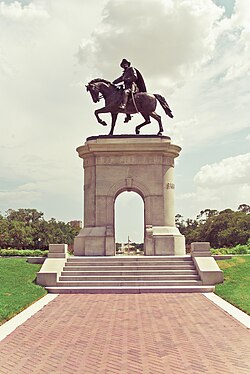
Simon Bolivar, also known as General Bolivar, is a bronze equestrian statue of Simón Bolívar by Adamo Tadolini. There are three casts which are located at the Plaza Bolívar in Lima, the Plaza Bolívar in Caracas and the United Nations Plaza in San Francisco, California.

Theodore Roosevelt, Rough Rider is an outdoor bronze sculpture by American artist Alexander Phimister Proctor, located in the South Park Blocks of Portland, Oregon in the United States. The equestrian statue was completed in 1922 and depicts Theodore Roosevelt as the leader of the cavalry regiment that fought during the Spanish–American War called the Rough Riders.
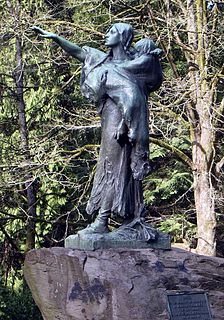
Sacajawea and Jean-Baptiste is a bronze sculpture of Sacagawea and Jean Baptiste Charbonneau by American artist Alice Cooper, located in Washington Park in Portland, Oregon, in the United States.

Pioneer Woman, also known as Joy, Joy , the Laberee Memorial Fountain, Mother/Child and Young Pioneer Woman, is an outdoor 1956 bronze sculpture and drinking fountain by American artist Frederic Littman, located at Council Crest Park in Portland, Oregon.

The Lewis and Clark Memorial Column is an outdoor monument by artist Otto Schumann, dedicated to Meriwether Lewis and William Clark for their expedition and located at Washington Park in Portland, Oregon.

The Promised Land is an outdoor bronze sculpture by David Manuel, located in Chapman Square, Plaza Blocks in Portland, Oregon.
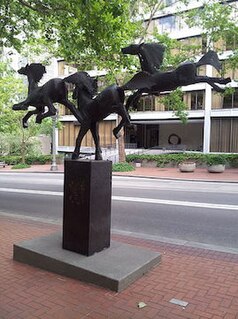
Running Horses is an outdoor 1986 bronze sculpture by Tom Hardy, located on the Transit Mall in downtown Portland, Oregon. It is part of the City of Portland and Multnomah County Public Art Collection courtesy of the Regional Arts & Culture Council.
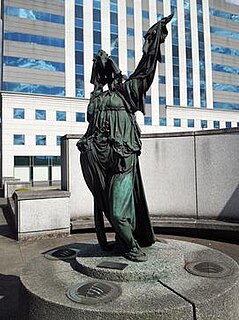
Ideals is an outdoor 1992 bronze sculpture by Muriel Castanis, located outside the Portland State Office Building in northeast Portland, Oregon.

George Washington is an outdoor 1926–27 bronze sculpture by Italian American artist Pompeo Coppini, located in northeast Portland, Oregon, in the United States.

Harvey W. Scott, or simply Harvey Scott, is a 1933 bronze sculpture by Gutzon Borglum depicting American pioneer, newspaper editor and historian Harvey W. Scott, located at Mount Tabor Park in the Mount Tabor neighborhood of Portland, Oregon.

Over the Top to Victory, also known as Doughboy Statue and Their Country's Call Answered, is an outdoor bronze sculpture by John Paulding, formerly located at the Marion County Courthouse in Salem, Oregon, United States. The statue was commissioned by the American War Mothers and the Gold Star Mothers Club to commemorate the 87 men and one woman from Marion County who died in World War I.

Jason Lee, also known as Reverend Jason Lee, is an outdoor bronze sculpture of Jason Lee, located in Salem, Oregon, United States. It was designed by Alexander Phimister Proctor, who died in 1950 when only the work's model was finished. His son Gifford MacGregor Proctor completed the sculpture between 1950 and 1953. The one installed on the grounds of the Oregon State Capitol is a duplicate of a bronze statue unveiled in the United States Capitol in 1952.

Untitled is an outdoor 1952 fountain and sculpture by Tom Hardy, installed at the Park Blocks in Eugene, Oregon, United States.

The Quest is an outdoor 1983 sculpture of Alice Biddle by Kirk St. Maur, installed on the Oregon State University campus in Corvallis, Oregon, in the United States.

Joan of Arc, also known as Joan of Arc, Maiden of Orleans, is an outdoor copy of Emmanuel Frémiet's equestrian statue Jeanne d'Arc (1874), installed in Portland, Oregon's Laurelhurst neighborhood, in the United States. The bronze sculpture, which depicts Joan of Arc, was donated to the city by Henry Waldo Coe, who saw Frémiet's original statue in Paris. Portland's copy arrived from France in 1924 and was dedicated on Memorial Day in 1925 in honor of the Doughboys of World War I.

John Harte McGraw is an outdoor 1912 bronze sculpture depicting the former governor of the same name by Richard E. Brooks, installed in McGraw Square at the intersection of Fifth Avenue and Olive Street in Seattle, in the U.S. state of Washington.

El Cid Campeador is an outdoor equestrian statue depicting the Spanish knight El Cid by artist Anna Hyatt Huntington, architect William Templeton Johnson, and the foundry General Bronze Company, installed at Balboa Park's Plaza de Panama, in San Diego, California. The bronze sculpture was created in 1927 and dedicated on July 5, 1930. The statue measures approximately 11 x 9 x 7 ft, with a 16-foot diameter, and its concrete or Indiana limestone base measures approximately 11 x 14 x 8 ft. It was surveyed and deemed "treatment needed" by the Smithsonian Institution's "Save Outdoor Sculpture!" program in March 1994.

Breyman Fountain, also known as the Breyman Brothers Fountain and Breyman Horse Trough, is an outdoor fountain by an unknown sculptor, installed in Willson Park, on the grounds of the Oregon State Capitol, in Salem, Oregon, United States.
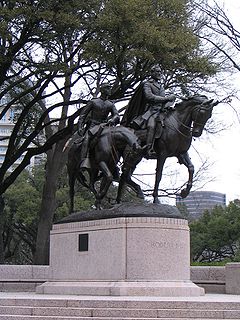
Robert E. Lee on Traveller is a bronze sculpture by Alexander Phimister Proctor depicting the Confederate general of the same name, his horse Traveller, and a young Confederate States Army officer, formerly installed at Dallas' Lee Park, in the U.S. state of Texas. The statue was unveiled by President Franklin D. Roosevelt in 1936, removed in 2017, and sold by the city for US$1,435,000 to a law firm.

Roman Gladiator is an outdoor 1881 bronze sculpture by Guillaume Geefs, installed in San Francisco's Golden Gate Park, in the U.S. state of California. The statue depicts a nude man holding a sword, and wearing a cloak and helmet. It measures approximately 100 x 36.25 x 33 inches, and rests on a base that measures approximately 40 x 44 x 44 inches. The bronze plaque on the front of the base reads: IN COMMEMORATION / OF THE INAUGURATION / OF THE / CALIFORNIA MIDWINTER INTERNATIONAL / EXPOSITION / ON THIS SPOT THE FIRST SHOVELFULL OF EARTH WAS TURNED / WITH CEREMONIES ON AUGUST 24th 1893. The sculpture was surveyed by the Smithsonian Institution's "Save Outdoor Sculpture!" program in 1992, and is administered by the San Francisco Arts Commission.
